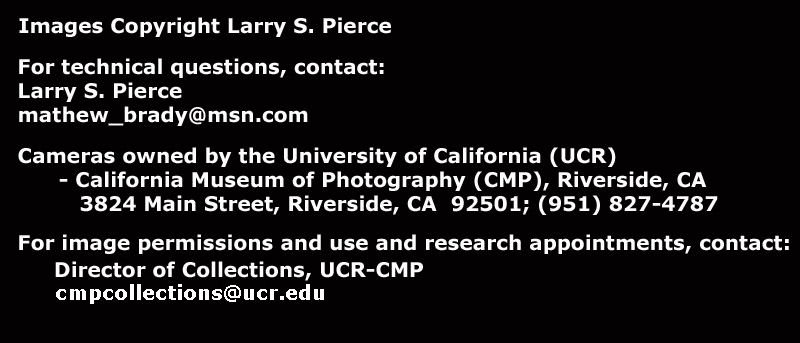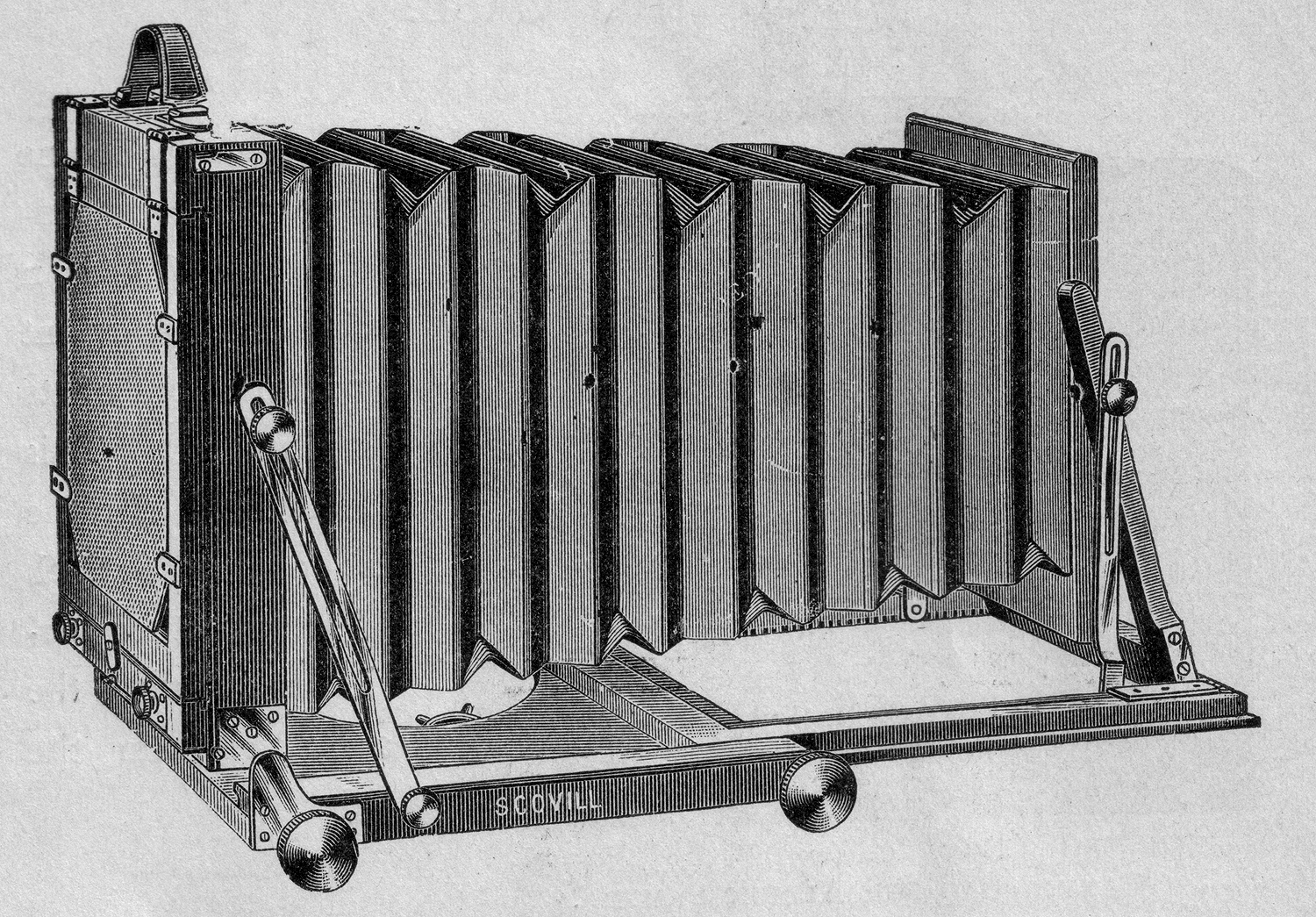Scovill Mfg. Co., Waterbury, CT & New Haven, CT
Albion Camera Variation 1.0 (brass hardware)
6½
x 8½;
a complete outfit as supplied by Scovill. The camera is stamped
with the assembly number "31" in four places. Even one of the
plate holders is stamped "40", but the other two are unmarked.
This camera has a 8" focal length wide angle rapid rectilinear-type lens
engraved: "184 Geo. Wale 6½x8½ 8in. Scovill" in a brass barrel mounted
in a George Wale shutter, with lens cap and the bottom of the leather
box/holder for stops and four stops (at least one stop and the top of
the box/holder are missing). The "184" is apparently the serial number,
which is repeated on each of the stops.
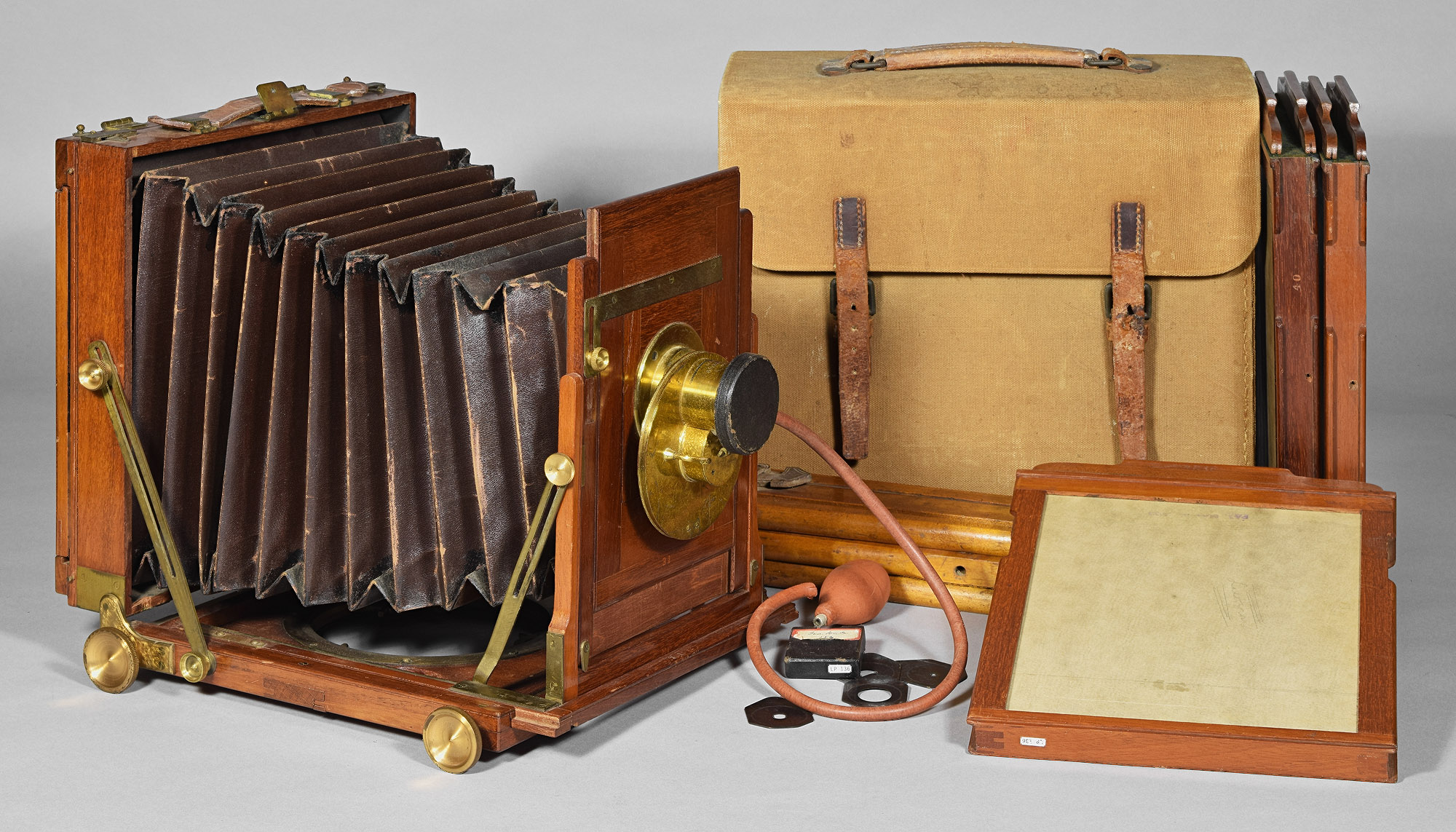
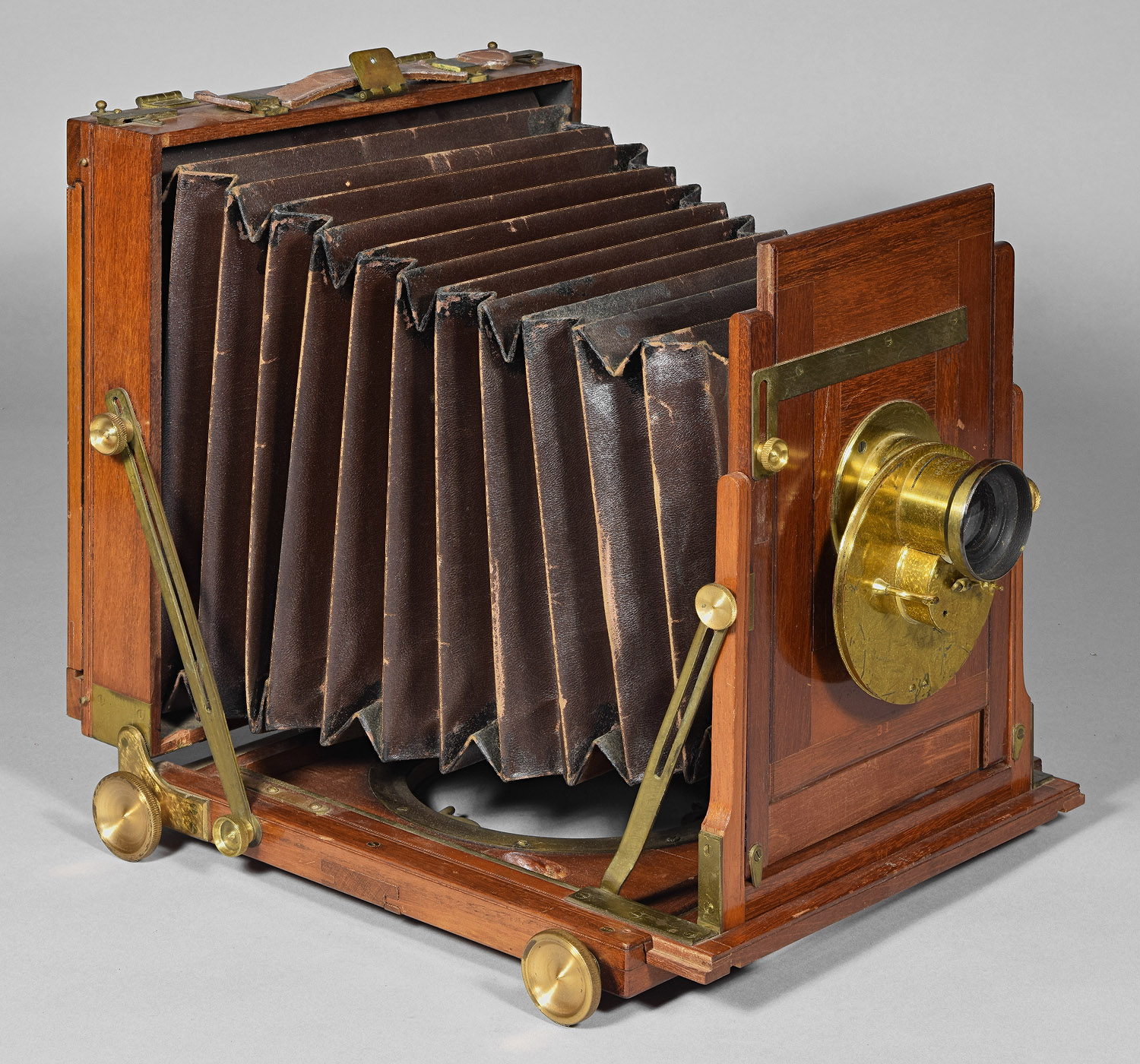
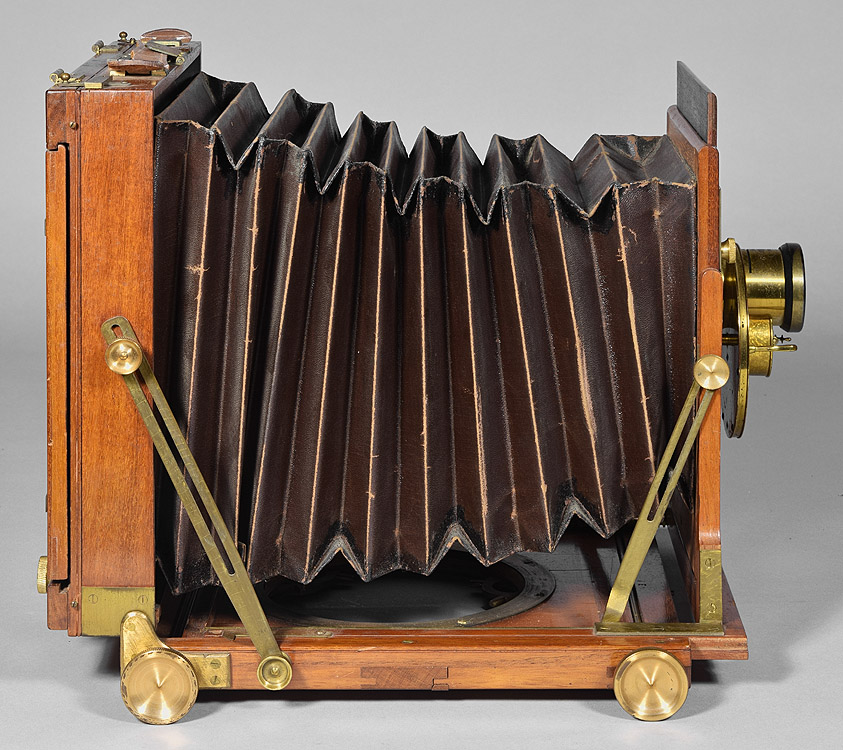
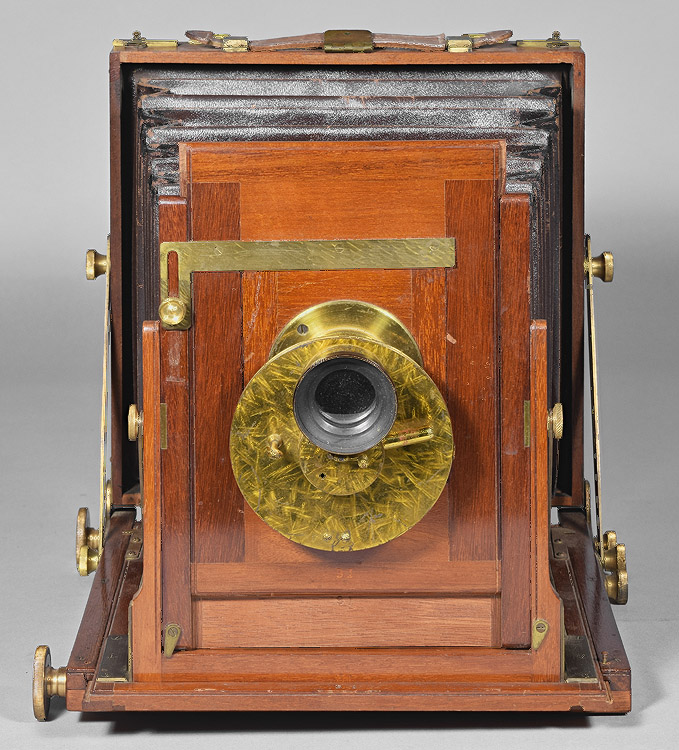
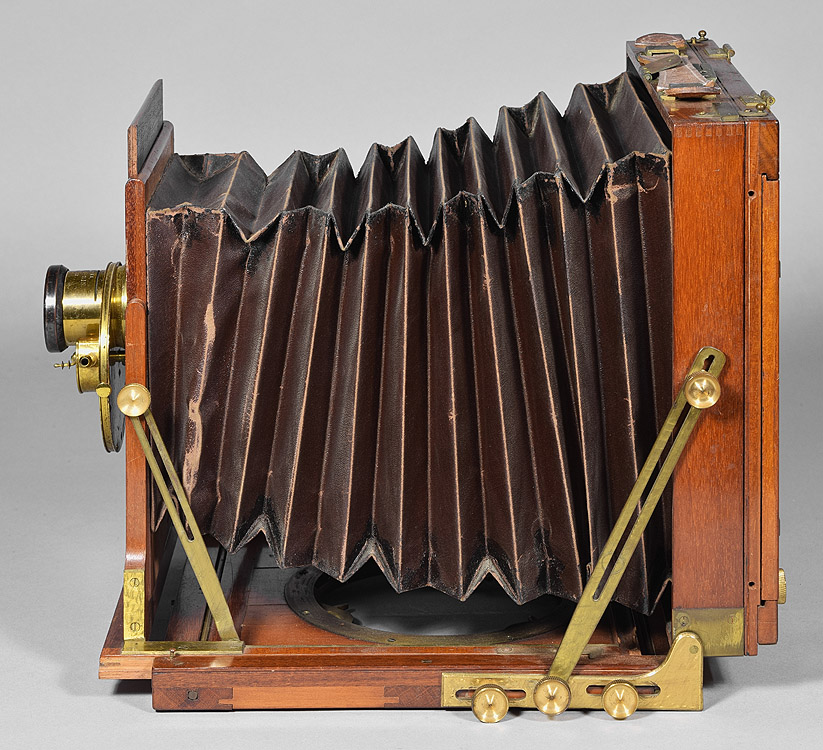
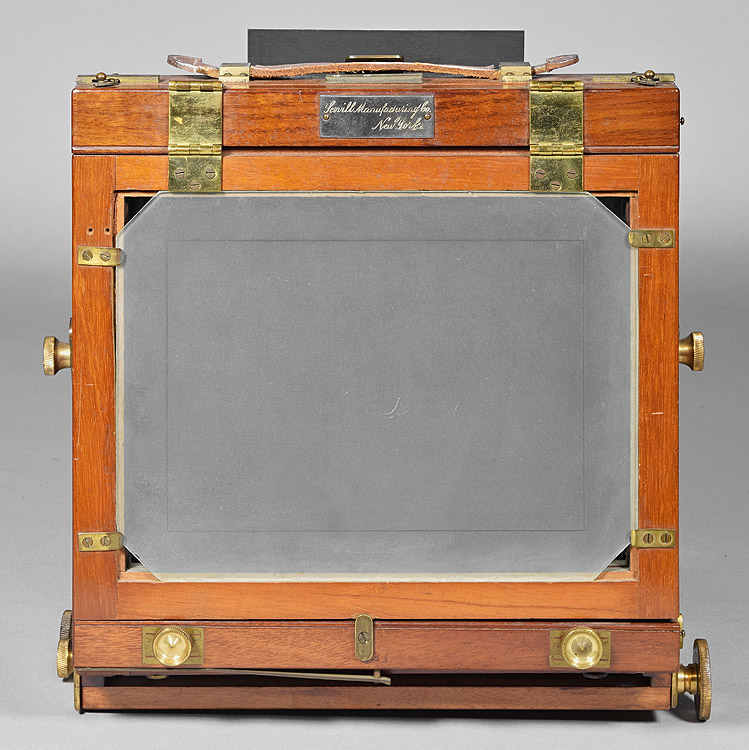
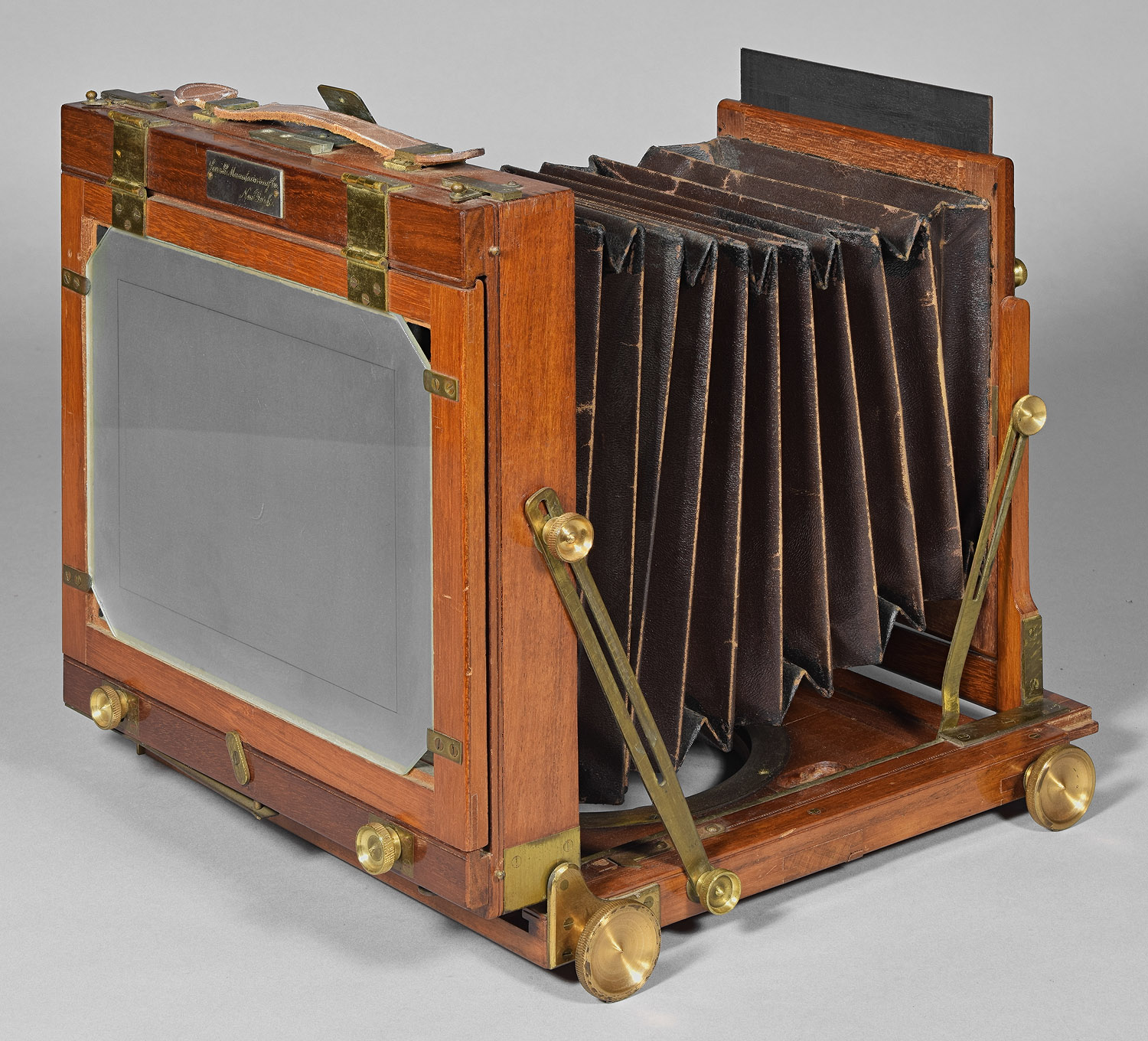
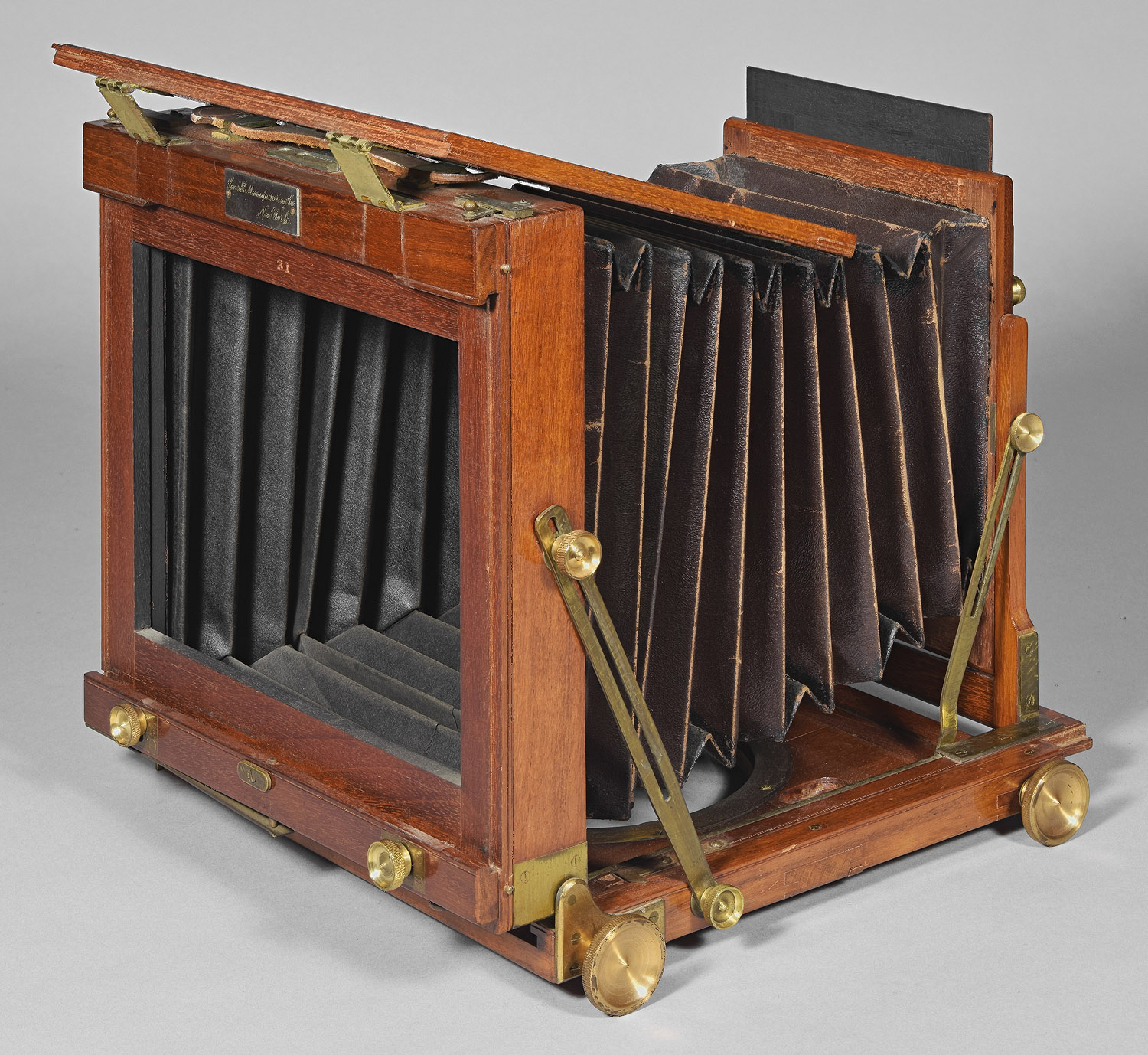
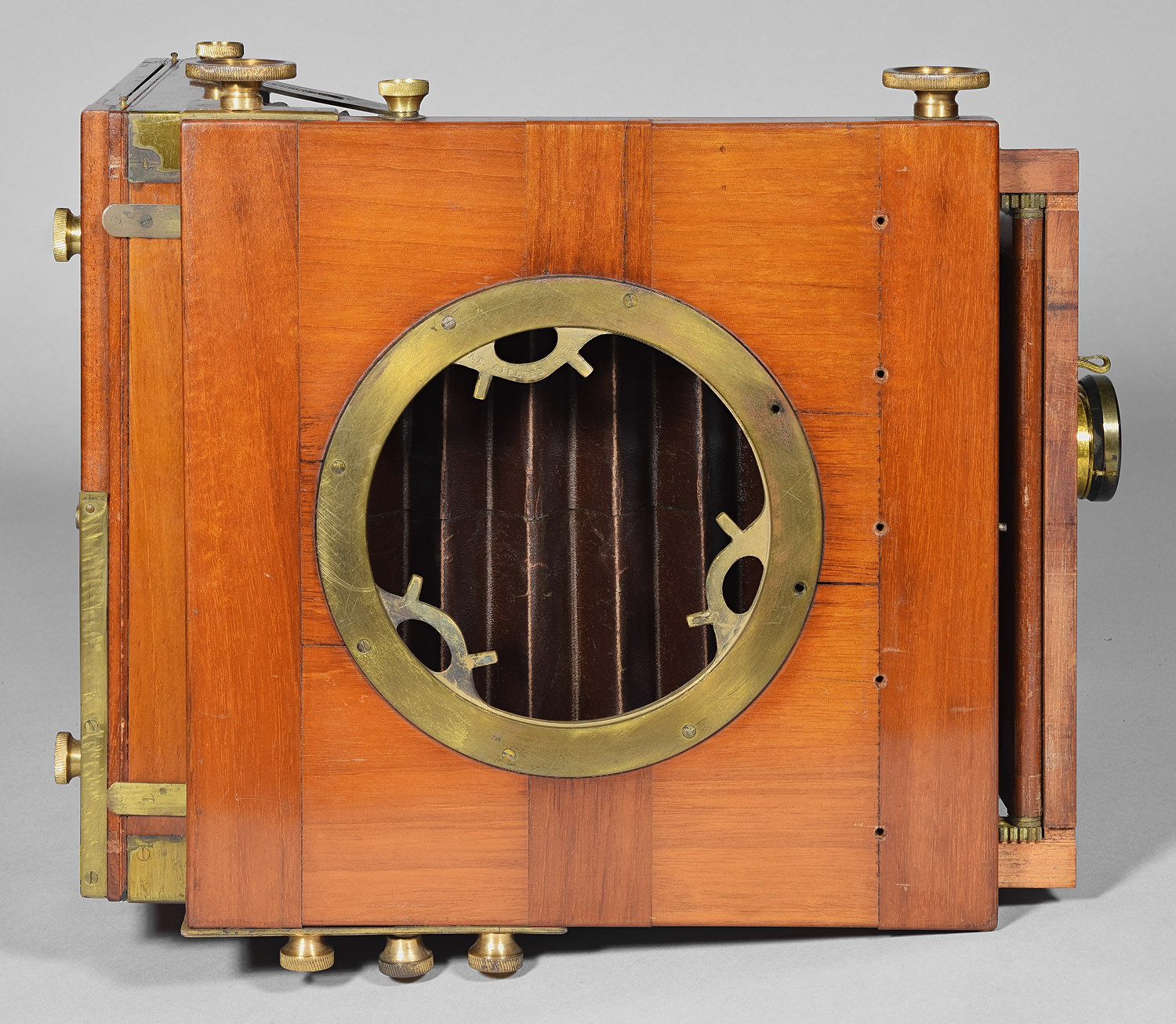
Metal label,
probably nickel-plated brass, at the upper part of the
rear standard.
Below it: assembly no. 31 normally hidden by the ground glass frame.
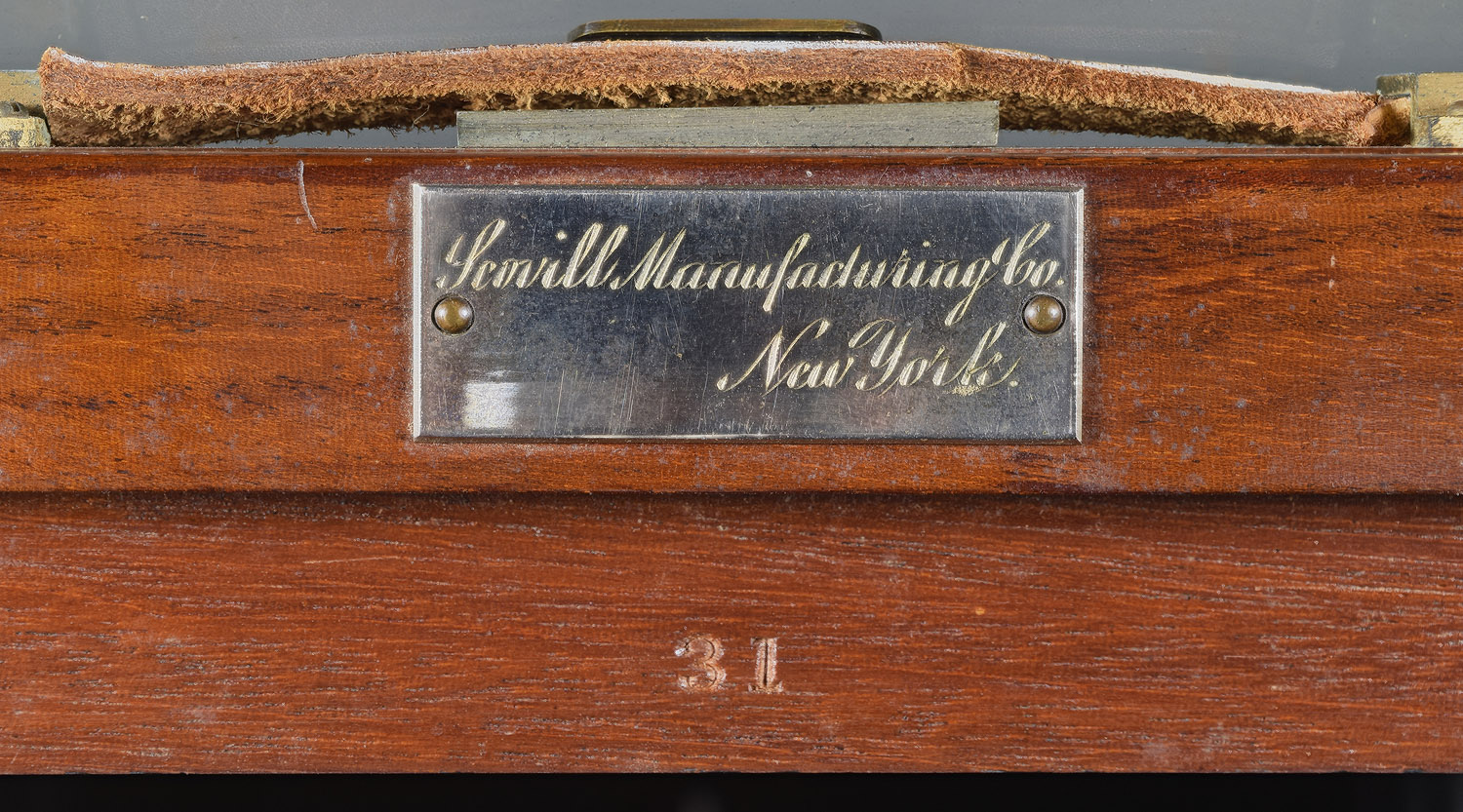
Manufacturer:
Scovill Mfg. Co.
Date Introduced: c.1887 ;
Years Manufactured: c.1887-1897
Construction: telescoping bed focus
via rack and pinion (gear tracks hidden); single front and double
back swing; reversing by removable back
Materials: mahogany body; mahogany bed;
black fabric bellows; brass hardware
Sizes Offered: #550=4¼x6½;
#551=5x7; #552=5x8; #553=6½x8½;
#554=8x10
Notes:
The Albion View Camera is an English Compact style of camera - hence the name Albion, from the oldest (and Greek) name for the island of England. English Compact refers to the clamshell-like way the camera folds up, which was a design made by a large number of manufacturers in the United Kingdom. Albion variations 1.0 through 2.0 even have an English-style flip-up or flip-down ground glass frame, and take English-style plate holders, which have a recessed groove on their long sides. The insertion of such holders could be described as sliding into an grooved back, an arrangement similar to a tongue and groove. Light would have to make 5 right angle turns to leak from the interlocking parts of the holder. This style of holder is common for cameras manufactured in the United Kingdom, but rare in the United States. The only thing that reveals an American source for the Albion would be the typical Scovill clips that secure the removable back. There are two platforms: an inner to which the front standard is attached, and an outer to which the rear standard is attached. Both standards pivot, either to close up the camera or to provide tilt from either standard. The inner platform may be moved either forward or backward via rack and pinion focus, using one or two (depending on variation) large diameter thumbscrews. The outer sides of the platform of Variation 1.0 through 1.5 are mostly wood, whereas Variations 2.0 and 3.0 have a full length slotted metal guide / reinforcement. Variations other than Variation 3.0 have a large circular hole in their bottom housing a tripod head. Three tripod legs fit onto six hefty brass pegs to complete the tripod.
It is a high end camera for Scovill - normally, one would expect such a French-polished, decorated brass model to have been made by the American Optical Co., Scovill's high-end manufactory, but Albions were always advertised as Scovill product, and therefore probably made in the Scovill New Haven, CT factory.
Albion Variation 1.0 has only a small amount of brass hardware on the side of the base/bed. The front standard is conventional, consisting of a vertical wooden frame capable of rise movement, and a separate lens board, retained via a metal strip at the top and a metal flipper at the bottom.
Albion Variation 1.1 is identical to the Variation 1.0 except that it has all nickel-plated hardware. Scovill catalogs do not appear to ever say whether the hardware is brass or nickel-plated. If it follows the rule of other camera models that appear in both brass and nickel-plated hardware, the brass version was the earlier variation, and replaced by the nickel-plated version either when marketing indicated that customers preferred nickel-plated, or when nickel-plated parts were found to be less expensive than the labor-intensive draw-filing and varnish method of finishing brass parts.
Albion Variation 1.5 is similar to the Variation 1.0 in that 1) its main platform has mostly wooden sides (rather than clad in slotted brass), and 2) its removalbe back has the hinged flip-up or flip-down ground glass frame, and uses English-style plate holders. But its front standard does not have a removable lens board and secured at its top by a horizontal metal strip, which also has a vertical slotted section for rise movement, like all other variations of the Albion. Rather, the front standard of Variation 1.5 is like Variation 2.0, in that it has a board the must be removed by pushing it up past the verical supports until it is completely removed. The same sliding motion provides rise movement. To lock the rise, the same two thumbscrews that allow the front standard to tilt backwards for storage must be used. Fortunately, the rise is rather tightly fitted, otherwise holding it all in place while tightening the screws might require more than two hands.
Albion Variation 2.0 has full length brass hardware on the side of the base/bed. Inasmuch as the above camera is marked Scovill Mfg. Co. and one of the observed Variation 2 cameras is marked Scovill & Adams Co. (the successor to Scovill Mfg. Co.), Variation 2 is though to represent a later version than Variation 1, being an improved version having a brass-reinforced side. The front standard of Variation 2.0 is like Variation 1.5, in that it has kind of an integral lens board, instead of being easily removed, like Variation 1.0. In the 1886 Queen catalog reference, a 4¼x5½" size is offered without lens on pages 84-85, and with a lens for bicycle use on page 77 as The Wheelman's Perfection Photographic Outfit. Introduced: not in the April 1887 catalog, but in the Sep. 1888 catalog.
Albion Variation 3.0 - Also called The Elm City View domesticates the Albion Camera for American use. The built-in tripod head has been replaced by a tripod screw hole of standard size and thread pitch. Variation 3.0 also continues the full length brass hardware along the base/bed, as in Variation 2.0. The removalbe back now has a four-spring-type (see below) for American-style plate holders.
The American Optical/Scovill & Adams
Co. Four Spring Back
This back consists of a ground
glass frame connected to the back of the rear standard using four
springs, one in each corner, and each about 2-3 inches long. As
One end of each spring is tightly screwed to the rear standard, while
the other end applies pressure onto the middle of a hinge made of sheet
brass about 2 inches long, which is attached, one end to the ground
glass and the other to the rear standard, via round-head wood screws
long enough to act as axles. Three of the corners appear as in the
left hand photo below. The fourth corner contains the spring, but
also an extra bit of hardware attached to the sheet brass that catches
in an open position on a post. This is shown in the right hand
photo below.

This type back found on a number of cameras in this
collection, including: A similar back is found on the 1)
Scovill & Adams labeled
Acme Reversible Back View Camera Variation 3, 2)
unlabeled
Albion Variation 3, 3)
American Optical, Scovill & Adams Co., Prop'rs
labeled Compact View Variation 2 or Irving View Variation 2,
4) American Optical,
Scovill & Adams Co., Prop'rs labeled Irving View Variation 1.(known
to have been introduced in March, 1892), 5)
Scovill & Adams labeled
St. Louis View Camera Variation 3, and 6)
Star View Camera
(introduced 1890) - one example labeled
The Scovill & Adams Co., the other example labeled
American Optical Co., Scovill & Adams Co.,
Prop'rs).
From the example cameras from six models that have four
spring backs, we find that all but one camera (and that one is unlabeled
and so indeterminate) are labeled and thus can be dated from when
The Scovill & Adams Co. were
proprietors of the American Optical Co.,
that is, 1889-c.1899. It would therefore appear that the four
spring back was introduced approximately when
Scovill Mfg. Co. changed to
The Scovill & Adams Co.
in 1889. The four spring design was patented in
1889 (granted to Scovill Mfg. Co. (W.H. Fuller, assignor), #407587, 23
Jul 1889), but, unlike most of their patents, the patent information is
not stamped into the wood or otherwise appear on cameras using the
patent.
References:
Back to American Optical
Co. / Scovill Mfg. Co. (alphabetical)
The American Annual of Photography and Photographic Times Almanac for
1888, C.W. Canfield, ed.; Scovill Mfg. Co. (New York, NY), copyright
1887, ads p. 58-61
How to Make Photographs and Descriptive Price List,
Scovill Mfg. Co. (New York, NY),
undated but about January 1888, p. 34-37
How to
Make Photographs and Descriptive Price List, Scovill Mfg. Co. (New
York, NY), May 1888, pp. 23-26
How to Make Photographs and Descriptive Price List,
Scovill Mfg. Co., distributed by John Wanamaker
(Philadelphia, PA), June 1888,
pp. 23-26
How to Make Photographs and Descriptive Price List,
Scovill Mfg. Co. (New York, NY), distributed by C.H.
Codman & Co. (Boston, MA), September
1888, p. 23-26
How to Make
Photographs and Descriptive Price List, Scovill Mfg. Co. (New York,
NY), November 1888, pp. 23-26
How to Make Photographs and Descriptive Price List,
Scovill Mfg. Co. (New York, NY), distributed by
Buchanan, Bromley
& Co. (Philadelphia, PA) Catalog, 1888
How to Make Photographs and Descriptive Price List,
The Scovill & Adams Co.
(New York, NY), January 1889, pp. 22-25
How to Make Photographs and Descriptive Price List,
The Scovill & Adams Co. (New York, NY), distributed by Buchanan,
Bromley & Co. (Philadelphia, PA) Catalog, 1889
How to Make
Photographs and Descriptive Price List, The Scovill & Adams Co.
(New York, NY, 1890, pp.24-27
American Annual of Photography and Photographic Times Almanac for
1890, The Scovill & Adams Co. (New York, NY),
p. 104
How to Make Photographs and Descriptive Price List,
The Scovill & Adams
Co. (New York, NY), distributed by Oscar Foss (San Francisco, CA), June
1890, pp. 24-27
How to Make Photographs and Descriptive Price List,
The Scovill & Adams
Co. (New York, NY), January
1891, pp. 24-27
How to Make Photographs and Descriptive Price List,
The Scovill & Adams
Co. (New York, NY), distributed by Sargent & Co. (Cleveland, OH), April
1891, pp. 15-18
How to Make Photographs and Descriptive Price List,
The Scovill & Adams
Co. (New York, NY), distributed by Horgan, Robey & Co. (Boston, MA),
June 1891, pp. 15-18
American Annual of Photography and Photographic Times Almanac
for 1892, The Scovill
& Adams Co. (New York, NY), 1891, ads p. 101
How to Make Photographs and Descriptive Price List,
The Scovill & Adams Co.
(New York, NY), January 1892, pp.
15-18
How to Make Photographs and Descriptive Price List,
The Scovill & Adams
Co. (New York, NY), abt. June 1892, p. 15-18
How to Make Photographs and Descriptive Price List,
The Scovill & Adams Co.
(New York, NY), April 1892,
pp. 15-18
American Annual of Photography and Photographic Times Almanac
for 1893, The Scovill & Adams Co. (New York,
NY), 1892, ads p. 83
Wilson's Cyclopaedic Photography, Edward L. Wilson (New York,
NY), copyright 1894, p. 477
American Annual of Photography and Photographic Times Almanac for
1897, The Scovill & Adams Co. (New York, NY),
1896, ads p. lxi (bargain page)
